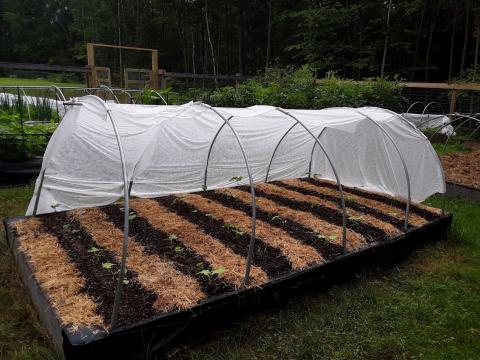Using Row Covers in the Garden

Row covers are an important tool for gardeners for season extension and pest control, sometimes dramatically reducing the need for pesticides while opening up weeks of extra growing time and helping speed up early season plant growth. There's no one way to use row cover, so it's important to tailor your practice to the crops you're growing, the time of year, and how much maintenance time you can invest.
What Is Row Cover
Row cover, also called floating row cover or spun-bonded row cover, is a light-weight and gauze-like white fabric made from polyester or polypropylene. Row cover ranges in thicknesses. A lighter weight fabric, might be labeled as .45 or .5 oz/sq. yd., whereas a heavier weight fabric might be labeled as somewhere between 1.5 and 2.2 oz/sq. yd. Row cover can be cut to size using sharp scissors, which is helpful because it typically comes in large rolls of varying widths and lengths.

Brands include Reemay, which is a spun-bonded polyester, Agronet, which is an ultraviolet-stabilized polypropylene and polyamide net, and Agribon, which is a spun-bonded polypropylene fabric. Other brands include Agryl, Harvest Guard and Typar.
Using Row Cover For Season Extension
Used properly, row cover can provide frost protection in the spring and the fall while also supporting rapid plant establishment and growth. Row cover increases both temperature and humidity under the cover, and the amount of insulation depends on the weight of the row cover. A lightweight row cover might provide 2ºF of frost protection, whereas a heavy-weight row cover might provide as much as 6ºF to 10ºF of frost protection.
In the spring, when transplants are small, row cover can often be simply draped over plants without a frame. Row cover should be weighed down - bricks, stones and garden staples are commonly used in a garden setting - but row cover can enable gardeners to experiment with pushing the planting window up by as much as several weeks in May. Used in this way, you can refer to the material as floating row cover.
.jpg)
For spring season extension, consider using row cover for tomatoes, peppers, eggplant, summer and winter squash, cucumber, pumpkin, melons, beans, greens, radish, broccoli, cauliflower, cabbage, kale, collards, chard, beets, potatoes and strawberries. Once we get to early June, a heavy-weight row cover would no longer be appropriate. Flowers and fruits of beans, tomatoes and peppers may abort when temperatures exceed 90ºF, and temperatures under the row cover could be as much as 15ºF higher than outside temperatures. Cool season vegetables, like greens and brassicas (broccoli, cauliflower, cabbage, brussels sprouts, collards, kale, etc.) are also sensitive to warm temperatures and row cover should typically be removed by early June.
Temperature isn't the only variable. For insect pollinated vegetables, like the nightshades (tomato, eggplant, pepper) and cucurbits (squash, cucumber, pumpkin, melon), row cover should be removed when female flowers bloom so as to allow pollination to occur. Enterprising gardeners may consider removing the row cover in the morning when pollinating bees are most active, and replacing the row cover in the afternoon and for overnight.
The final consideration is when plants like tomato need to be staked or caged, and when plants like pole beans and vining cucumbers get too tall. At that point, row cover either needs to be supported with a frame or removed.
Other Season Extension Materials
Shade cloth, which may also be referred to as shade fabric, is typically a knitted or woven UV stabilized polyethylene fabric that blocks or reflects some amount of sunlight without re-radiating the heat onto your plants. Shade cloth comes in a variety of densities, ranging from 10% to upwards of 60%. Shade cloth reduces temperatures underneath the cloth, and if used properly, can support plant health and production in times of intense summer heat. While row cover would typically be used for season extension in the spring and fall, shade cloth would typically be used over the summer, either to extend the growing season for cool season crops into warmer months or to protect warm-season crops like tomatoes and peppers from intense heat that could cause plants to abort flowers and fruit or experience physiological disorders like sunscald. With cool season crops, the use of shade cloth could prevent greens, herbs and brassicas from bolting or going to seed prematurely, and might also prevent some vegetables from developing a bitter flavor.
If you use shade cloth, it's important to use a frame that creates some space between the plants and the cloth, which allows the cloth to work as intended as well as supports better air flow. If the shade cloth touches the foliage of the plant, you risk injury to the plant from direct heat transfer from the fabric to the plant.
You can also achieve shade in your garden through thoughtful design and companion planting, and protect plants from heat stress by fertilizing at recommended rates, using organic mulch and watering early in the morning.
To protect from frost, alternatives to row cover include frost blankets, plastic coverings, and tarps. These materials should just cover plants at night, especially when temperatures drop below 30ºF. Double layers of materials will provide even more protection when temperatures drop below 28ºF. Whether you're using row cover or an alternative covering, it's crucial to weigh them to the ground, both to protect them from blowing in the wind and to prevent heat from escaping. With any kind of plastic material, ensure that the plant's leaves aren't coming in direct contact with the material, as that can lead to injury. Remember to take frost blankets, plastic coverings and tarps off your plants during the day.
If you are looking beyond season extension and towards growing crops over the winter, you will want to consider cold frames or even a high tunnel.
Pest Exclusion and Management
When used properly within an Integrated Pest Management approach, row cover can create a barrier around your plants to exclude insects, as well as some animals like rabbits, birds and deer.
General best practices:
- Scout these plants frequently while the row cover is on your plants in the spring, both to check for pest and disease issues, check moisture levels, keep weeds under control under the row cover and check temperatures to ensure it's temperatures don't spike past 90ºF under the covers.
- Remove row cover when insect-pollinated plants begin to flower.
- Rotate crops each year, paying special attention to crop families to ensure you are rotating crops to a part of the garden where a crop of a different family was grown the previous year.
Pests that can be excluded with row cover, by crop:
Tomatoes and peppers: Aphids, cutworms, flea beetles
Eggplants and potatoes: Aphids, Colorado potato beetle, flea beetles
Cucumber, melon, pumpkin, squash: Aphids, cucumber beetles, squash bugs, squash vine borer*
Broccoli, cabbage, cauliflower and other brassicas: cabbage maggots, cutworms, flea beetles, cabbage loopers, cabbage worms
For vegetables that don't rely on insect pollination, like beans, leafy greens, cabbage and potatoes, you can replace row cover with a fine insect netting, which might also be called insect barrier. This material excluded insects without increasing temperatures or providing frost protection. It may block up to 10% of light, but that's generally slightly more light transmission than row cover allows. Insect barrier is lighter weight than row cover, and a valuable tool for heat-sensitive crops.
Establishing Row Cover and Frames
Before using row cover, mulch should be applied around your transplants to suppress weeds and retain moisture.
Drip irrigation or soaker hoses are ideal choices for irrigating crops under row cover. If your row cover is supported by a frame, you will have to peel it back to water, so drip irrigation or soaker hoses offer a far less labor intensive and more efficient way of watering your garden.
Supporting your row cover with frames allows you to keep your row cover on plants longer, and can likewise support other fabrics. Consider using either a low-tunnel design or an A-frame, both of which can be designed with either PVC piping, wood, or flexible wire such as electric fence wire or 9-gauge wire. Rebar is helpful for supporting low tunnels, although not necessary for a simple wire-based design, whereas you might use fence posts to support an a-frame. You can purchase these materials pre-fabricated from garden supply stores or as raw materials from local suppliers.
If you are creating frames for individual rows, plan for frame pieces to be spaced every four feet or so along the row, and target hoops approximately 16 to 20 inches high. For a 4-foot row, wire pieces should be about 6 feet in length. At the ends of your rows, consider using double layered hoop pieces if you're using wire because the row cover exerts the most pressure on the ends.
It's helpful to be able to easily vent your row cover on warm days in the spring, so consider how you might peel back the sides. While peeling back the sides and venting your row cover allows pests in, it may be necessary on especially warm days without going through the hassle of completely removing the cover.
Maintaining Row Covers
If taken care of properly, row covers can be reused for several seasons. Store row cover in either sealed plastic bags or sealed containers. Do not leave row cover exposed in a bar, garage or shed as mice may nest in the material. Treat your insect netting and shade cloth in the same way. While row cover is relatively inexpensive, it's always better to use material for multiple seasons if you can as expenses add up quickly in the garden.
Got questions? The Ask UNH Extension Infoline offers practical help finding answers for your home, yard, and garden questions. Call toll free at 1-877-398-4769, Monday to Friday, 9 a.m. to 2 p.m., or e-mail us at answers@unh.edu.
Do you love learning about stuff like this?
SUBSCRIBE TO Granite State Gardening newsletter
Got questions? The UNH Extension Yard and Garden Infoline offers practical help finding answers for your yard and garden questions.
Call toll free at 1-877-398-4769, Monday to Friday, 9 a.m. to 2 p.m., or fill out webform.

